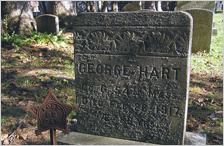|

Due to the nearly complete preservation of 19th century Woodstock, sites
associated with the Underground Railroad, abolition meetings, the town's free
African-American community, and Woodstock's pivotal role in the Union war effort
in Vermont, are preserved within an extraordinarily intact setting. Marsh-Billings-Rockefeller
NHP preserves resources connected with conservationist George Perkins Marsh,
who as Lincoln's ambassador to Italy, vigorously represented the Union cause
in Europe, and Frederick Billings, who worked to rebuild Vermont's rural population
depleted by war losses and agricultural collapse.
 |
 |
Marsh-Billings Rockefeller National Historical Park, as the first National
Park offering a tour devoted to the Civil War home front, adds value to the
efforts of Civil War sites throughout the National Park Service, to provide
a much broader context to public interpretation of the Civil War. Woodstock's
free African-American community played an outsized role in the conflict. The
second largest free black community in Vermont, it sent twelve of its citizens
to fight with the famed Massachusetts 54th Regiment (Vermont's black population
was not large enough to field its own military units.) Using first person accounts
and real places, the "Home Front" program specifically explores the impact
of race and slavery on antebellum American social and political institutions,
the evolution of anti-slavery resistance and the nation's spiraling descent
into civil war. The program encourages a dialogue on the nature of a democracy
and the role of compromise and tolerance in maintaining civil society.
The "Home Front" tour concludes at Marsh-Billings-Rockefeller NHP examining
the park's special connection to the Civil War and the ways the terrible struggle
also provided an opening for "a new birth of freedom" including seminal thinking
on stewardship of natural resources and guaranteed public access to great landscapes
like Yosemite. In 2004, the award winning Woodstock Union High School "Speak Chorus," who
have performed their intricately choreographed civic choruses on several occasions
at the Kennedy Center, will dramatize the Civil War Woodstock Home Front Project with
a 20 minute performance focusing on the themes of freedom and civil rights. This is an
unusual example of young people involved in civic engagement using literature, music
and theater.
Frederick Law Olmsted in his report to the Commissioners of Yosemite 1865
"It was during one of the darkest hours, before Sherman had begun the march
upon Atlanta or Grant his terrible movement through the Wilderness…that consideration
was first given to the danger that such scenes [speaking of Bierstadt and
Watkin's art of Yosemite] might become private property..."
Robin Winks in his biography of Frederick Billings, "Frederick Billings: A
Life"
"The creation of a park in far away California was a statement about national
unity, continental status, and hopes for an optimistic future in the midst
of a devastating civil war: Yosemite was a monument to union, democracy, and
long-term goals for the nation, the product of a great national need."
Full Case Study (PDF) »
Get FREE Adobe Acrobat Reader »

|



